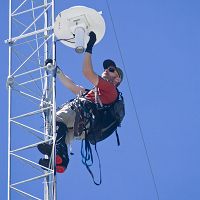Kerkez et al., 2012
Design and Performance of a Wireless Sensor Network for Catchment-scale Snow and Soil Moisture Measurements.
Kerkez, B., Glaser, S.D., Bales, R.C., and Meadows, M.W. (2012)
Water Resources Research, 48 (9), W09515
-
Sierra, COLLABORATOR
-
Sierra, INVESTIGATOR
-
Sierra, INVESTIGATOR
-
Sierra, STAFF
Abstract
A wireless sensor network (WSN) was deployed as part of a water balance instrument cluster across a forested 1 km2 headwater catchment in the southern Sierra Nevada of California. The network, which integrates readings from over 300 sensors, provides spatially representative measurements of snow depth, solar radiation, relative humidity, soil moisture, and matric potential. The ability of this densely instrumented watershed to capture catchment-scale snow depth and soil moisture distributions is investigated through comparison with three comprehensive gridded surveys and 1 day of detailed lidar snow data. Statistical analysis shows that the network effectively characterized catchment-wide distributions of snow depth, while offering a cost-effective, reliable, and energy-efficient means for collecting distributed data in real time. A temporal analysis of snow depth variability reveals that canopy cover is the major explanatory variable of snow depth and that under-canopy measurements persistently show higher variability compared to those in open terrain. An analysis of soil moisture shows lower variability at deeper soil depth and a correlation between mean soil moisture and variability for shallow soils. A three-phase design procedure was used to optimize the WSN deployment. First, as off-the-shelf performance of current WSN platforms for large-scale, long-term deployments cannot be guaranteed, statistics from a prototype deployment were analyzed. Two indicators of network performance, the packet delivery ratio and received signal strength indicator, showed that for our site conditions, a conservative 50 m node-to-node spacing would ensure low-power, reliable, and robust network communications. Second, results from the prototype were used to refine hardware specifications and to guide the layout of the full 57-node wireless network. Of these nodes, 23 were used actively for sensing, while the remaining 34 nodes were used as signal repeaters to ensure proper spatial radio coverage and robust network operations. Further analysis of network statistics is conducted during the third, operational, phase to validate system performance.
Citation
Kerkez, B., Glaser, S.D., Bales, R.C., and Meadows, M.W. (2012): Design and Performance of a Wireless Sensor Network for Catchment-scale Snow and Soil Moisture Measurements. Water Resources Research, 48 (9), W09515. DOI: 10.1029/2011WR011214
 This Paper/Book acknowledges NSF CZO grant support.
This Paper/Book acknowledges NSF CZO grant support.
Explore Further




